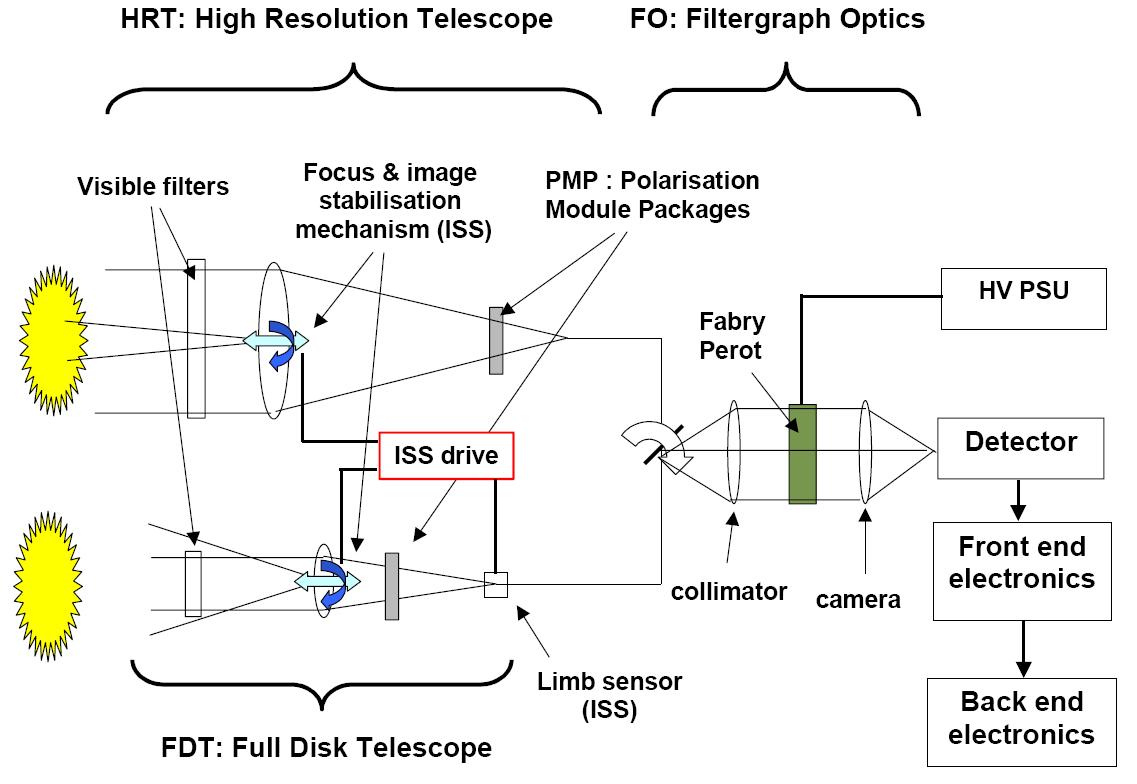Introduction
Science objectives
The Visible-Light Imager and Magnetograph (VIM) will determine the boundary conditions for the MHD processes observed by other remote sensing instruments on Solar Orbiter. It will observe the morphology and dynamics of magnetic field structures and plasma motions at the photospheric level. Its resolution is consistent with the resolution of the EUV telescopes.
VIM will have vector magnetic field capabilities as this is of fundamental importance to understand the nature of photospheric magnetic fields. Having vector capabilities is also the only way in which quantitative inferences of the magnetic field in the transition region and corona can be made (from force-free or full 3D MHD extrapolations)
VIM will produce line-of-sight velocity maps by determining the Doppler shift of a spectral line. These maps can be used, through local helioseismology techniques, to investigate sub-surface flows. The internal structure and dynamics of the near-polar regions of the Sun is of paramount importance and perhaps THE key to our understanding of the solar cycle.
VIM will also provide images, Dopplergrams and magnetograms from the far side of the Sun (the side which is not seen from Earth).
The key scientific goals of VIM are:
- Magnetic coupling science: Photospheric vector-magnetograms allow 3D field extrapolations into the transition region and corona.
- Polar view: Helioseismic and magnetic field measurements at the Sun's polar regions will provide crucial constraints on the solar dynamo theories.
- Stereoscopy: Simultaneous observation from different viewpoints (co-ordinated with near-Earth-orbit instruments) will establish a stereographic view of photospheric structures. VIM will provide even data from the Sun's far side.
- Co-rotation: Long-term observations of structures from almost non-variable vantage points will be enabled during perihelion passages.
- Helioseismology: VIM will continuously provide high-cadence velocity maps, excellently suitable for both local and global helioseismic studies of sub-surface flows and magnetic field structures.
Instrumental concept
The VIM instrumental concept consists of:
- HRT: a 125 - 160 mm diameter High Resolution Telescope which achieves an angular resolution of 1.00 arcsec (150 km on the Sun at minimum perihelion distance of 0.22 AU). Its field of view will be 1000 x 1000 arcsec2
- FDT: a 13 - 17 mm diameter Full Disk Telescope which will obtain 2k x 2k full disk images.
- FO: a Filtergraph Optics based on two LiNbO3 Fabry-Pérot etalons. Its transmission passband will be between 7 and 10 pm wide and its central wavelength shall be tunable in a range of +/- 0.1 nm around the FeI 617.3 nm spectral line
- PMP: two Polarisation Modulation Packages based on liquid crystals which will allow VIM to provide longitudinal and transversal magnetograms of the region being observed.
- ISS: Due to data processing requirements the VIM pointing needs to be extremely stable, better than 0.02 arcsec in 10 s, and, therefore, an Image Stabilisation System will significantly improve over the pointing accuracy of the spacecraft
 The two telescopes alternatetly deliver images of the Sun's photosphere at
a common focal plane. The Filtergraph Optics produces magnified images of
narrow bandwidth using a double Fabry-Pérot interferometer. The wide tuning
range of the FO allows scanning across the FeI 617.3 nm spectral line. In
addition, Doppler shifts of +/-0.06 nm, emerging due to cruise speed variations
of the spacecraft, have to be compensated for. The two PMP packages will produce
modulation on an APS detector as a function of the polarisation state of the
incoming light. The intensity change will be used to recover the Stokes vector of
the solar light, which allows a determination of the full magnetic field vector and
the line-of-sight velocity by means of Milne-Eddington inversion calculations.
The two telescopes alternatetly deliver images of the Sun's photosphere at
a common focal plane. The Filtergraph Optics produces magnified images of
narrow bandwidth using a double Fabry-Pérot interferometer. The wide tuning
range of the FO allows scanning across the FeI 617.3 nm spectral line. In
addition, Doppler shifts of +/-0.06 nm, emerging due to cruise speed variations
of the spacecraft, have to be compensated for. The two PMP packages will produce
modulation on an APS detector as a function of the polarisation state of the
incoming light. The intensity change will be used to recover the Stokes vector of
the solar light, which allows a determination of the full magnetic field vector and
the line-of-sight velocity by means of Milne-Eddington inversion calculations.